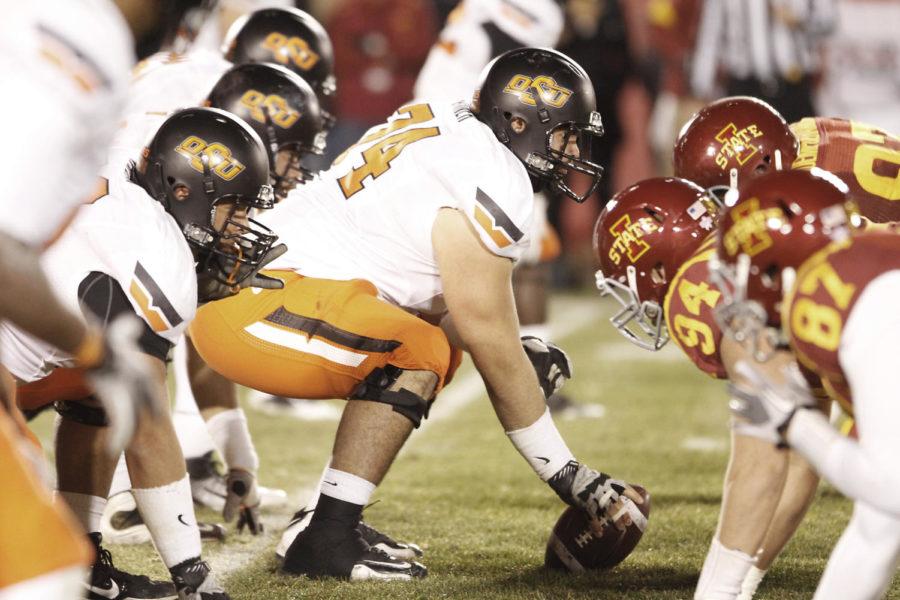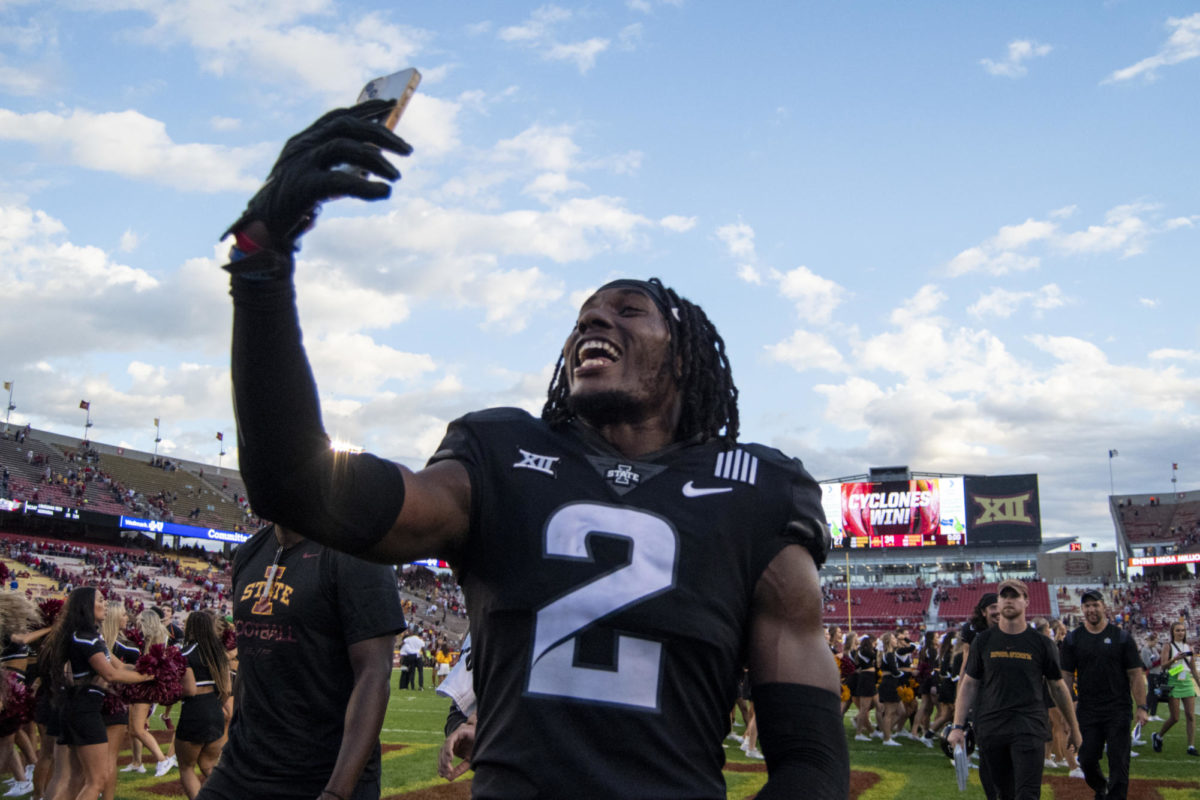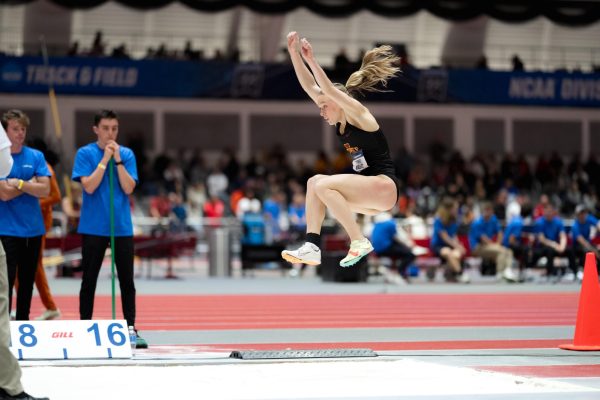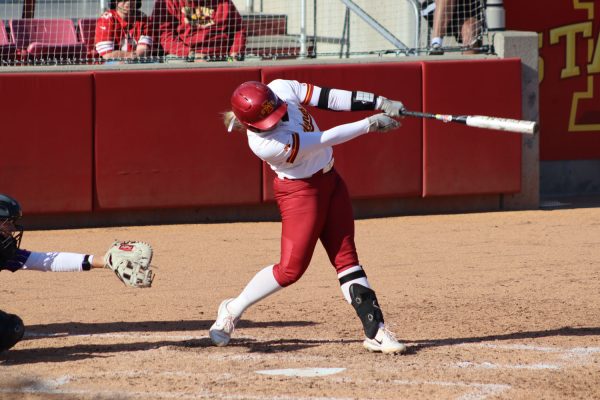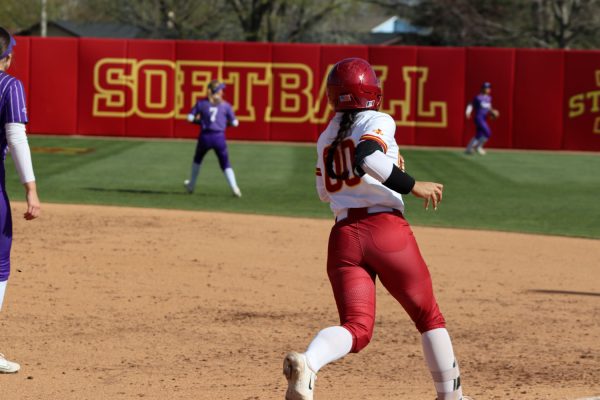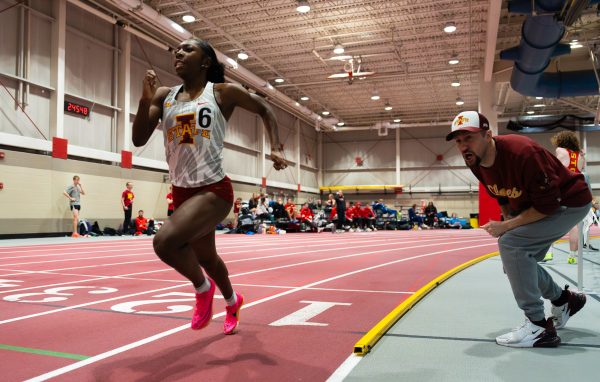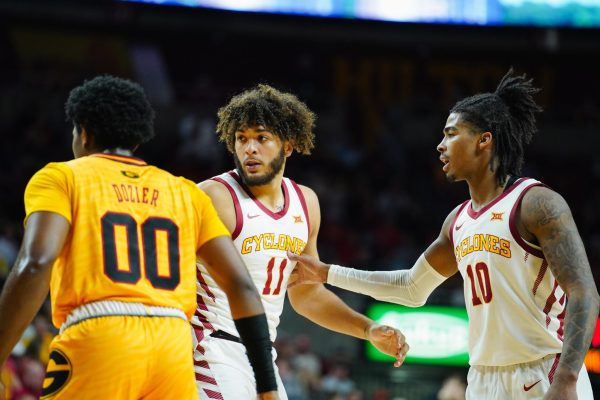Calhoun: Farewell, folks
May 6, 2013
Oh what a ride it has been.
With this column for the spring 2013 finals tab, my four-year career as a sportswriter for the Iowa State Daily will come to a close.
In my eight full semesters at the Daily, I’ve covered four NCAA Division I wrestling tournaments as well as 22 ISU football games — including the Pinstripe Bowl and the Liberty Bowl.
I watched ISU fans storm the field of Jack Trice Stadium twice in 2011 after two unthinkable overtime upsets. I’ve covered ISU volleyball matches in a high school gym after the summer floods of 2010 had damaged Hilton Coliseum.
I’ve seen the raw emotion of Jake Knott’s tearful goodbye from his season-ending shoulder surgery, cutting short his ISU career. I’ve seen Jon Reader — with bandages on his bruised, bloodied face — jump into coach Kevin Jackson’s arms after capping off his undefeated senior campaign with a national title.
I’ve flown by myself and with my co-workers to cover events, as well as driven vastly different distances — as short as the 90-minute wink to Iowa City, Iowa, to the 16-hour excruciating red-eye voyage to Austin, Texas.
I was assigned a story before I had even taken a college class and had it ripped to shreds, molding me into the editor that I am today.
These experiences have all served their intended purpose: to teach. In these four years, I’ve learned countless lessons, and there are a few that I feel are worth sharing.
1. In sports, nothing is impossible
Leading up to the prime-time football game on Nov. 18, 2011, I was absolutely convinced that Iowa State didn’t have even an ounce of a shot to beat No. 2 Oklahoma State. On paper, it really didn’t.
Oklahoma State was ranked first in the nation in numerous offensive categories and was a sure lock to land in the national title game. Quarterback Brandon Weeden was on fire and his favorite target, two-time Biletnikoff Award winner Justin Blackmon, had more than 1,100 receiving yards heading into that game.
On top of that, Iowa State looked poised for a beatdown after struggling to stop the run two weeks prior in its 13-10 win against Kansas, the Big 12’s cellar-dweller the past three seasons.
Of course, the Cyclones found themselves in a 17-point deficit at the beginning of the second half. At that time, I sat in the press box with one thought on my mind: “Where have we seen this before?”
Iowa State was synonymous with letdowns in critical moments: It let Texas jump out to a 34-0 lead in the Big 12 opener, squandered its opportunities and let Baylor slip through its fingertips, couldn’t even get going in a 52-17 beatdown by Missouri and played the role of doormat to Texas A&M in its Homecoming game.
With those four head-shaking losses in mind, I rolled my eyes out of their sockets at the notion of an upset here.
But the Cyclones scaled that deficit, tying the game at 24-24 to send the game into overtime.
On the first play from scrimmage in the second overtime, senior ISU safety Ter’Ran Benton picked off Weeden to officially put my predictions in doubt.
From there, running back Jeff Woody buffaloed through the OSU defense for three-straight carries to touch pay dirt and end the game in what is considered the greatest upset in school history — its only victory against a team ranked higher than No. 7.
I scrambled to pick up my jaw off the floor as I sprinted down the side stairs of the Jack Trice Stadium press box heading for interviews, completely in awe of what had just happened.
To this day, I still admit I was very wrong.
However, if that game was played 100 times, I’d put all my nickels on the notion that Oklahoma State would win 99 of them.
Of the 22 ISU football games I’ve covered the past two seasons, that one was all it took to show me that nothing is impossible in sports.
2. Rome wasn’t built in a day
As an enthusiastic freshman reporter, I was assigned to cover the ISU wrestling team in what turned into my first big break.
That year, Jackson’s first as coach, the Cyclones were ranked No. 2 in the nation during the regular season and placed third at NCAAs with national titles from Jake Varner (197 pounds) and David Zabriskie (heavyweight).
After that year, everything went downhill.
Jon Reader won the national title at 174 pounds in 2011, but even that wasn’t enough to keep Iowa State from finishing 20th at NCAAs — its worst since 2003 when it placed 19th. That was followed by an injury-plagued 35th-place finish, the program’s worst-ever showing in which it failed to crown an All-American for the first time since 1962.
Coaching changes happen all the time, but some don’t quite pan out for at least one of the schools involved. Cael Sanderson found success at Penn State — winning the last three national titles — so Jackson’s tenure at Iowa State was not as bright comparatively, especially with the injuries his wrestlers had suffered.
However, there’s something a lot of disgruntled Cyclone fans forgot when it came to Jackson’s arrival: Coaching grown men on the U.S. national freestyle wrestling team, as Jackson did from 2001-08, and coaching college kids are two completely different tasks.
The maturity levels between them are rarely similar and once Jackson figured that out, the success followed considering the talent he had recruited.
In every dual meet since their loss to Iowa last December, Jackson’s Cyclones wrestled with a tenacity that was almost absent the past two years combined.
All 10 wrestlers were aggressive, shooting for ankles and legs even if they already had a comfortable lead.
It was an attitude that makes Tom Brands’ Hawkeyes so good: They wore you down and kept going without any regard for the score or time remaining.
Aside from a few minor hiccups at nationals, Iowa State’s newfound swagger produced three All-Americans and an 11th-place finish. This gained Jackson’s team some ground with a youth-dominated team vying for an even better finish next year.
It may not have been the first four years ISU fans had hoped for, but as they say, Rome wasn’t built in a day.
3. You can’t be afraid
This last segment was originally titled “No cheering in the press box” in reference to former ISU information director Tom Kroeschell’s famous declaration over the sound system in the press box at Jack Trice Stadium before kickoff. “None, nada, nyet.”
But I’d like to offer the most important piece of wisdom to anyone reading this, whether you’re my father’s age or going to ship off to college in the fall: You can’t be afraid.
After the ISU football team’s 52-17 shellacking to Missouri on Oct. 15, 2011, anyone wearing cardinal and gold in Columbia, Mo., was in an awful mood.
Quarterback Steele Jantz failed to spur a single offensive touchdown drive while leading the Cyclones to just 10 first downs in three quarters.
So ISU coach Paul Rhoads decided to put redshirt freshman Jared Barnett in to start the fourth quarter.
That quarterback change was obviously the question of interest for reporters after the game. It was something that needed to be asked, but no one wanted to ask it.
So I did.
Exactly 1:53 into Rhoads’ interview, I finally chime in: “Coach, could you talk about Jantz and why he was pulled in favor of Jared Barnett?”
After a three-second pause, he answered.
“Because we were a good bit behind and still hadn’t led a touchdown drive,” Rhoads said, glancing at me to his left. “So I didn’t think I’d consult with you, I just thought I’d make the decision myself and put Jared Barnett out there and see what he could do with our offensive football team.”
I’ll admit, I’m not the smoothest talker of the bunch and some of my questions can come off as awkwardly worded.
I don’t blame Rhoads for giving the answer he did, his team had just gotten its face smeared in the dirt. But my question still opened the topic up for others and that’s really all I wanted.
However, that was one of the few times in my college career that I truly felt fearless, that I could do something without over-thinking the repercussions as I so often have throughout the course of my adult life.
I often look back at these past four years with regret that I didn’t take more risks, and I’ll have to live with those “could-have-beens” for the rest of my life.
That’s why you can’t be afraid.
Don’t be reckless in rejecting your fears, but be willing to take risks and always accept their consequences.
If someone says “no,” then ask them “why?” If something doesn’t work, then find something that will.
As Ferris Bueller once said, “Life moves pretty fast. If you don’t stop and look around once in awhile, you could miss it.”
That it does, folks. That it does.
—
Jake Calhoun is a senior in journalism from Urbandale, Iowa.

